Donate
| SECTION I | ---------------------------------- | INTRODUCTION |
| SECTION II | ---------------------------------- | POINT AMBUSH |
| SECTION III | ---------------------------------- | AREA AMBUSH |
| SECTION IV | ---------------------------------- | UNUSUAL AMBUSH TECHNIQUES |
| SECTION V | ---------------------------------- | AMBUSH PATROLS |
153. General
a. An ambush is a surprise attack from a concealed position upon a moving or temporarily halted target. It is one of the oldest and most effective types of military operations.
b. Ambush may include assault to close with and decisively engage the target, or the attack may be by fire only.
o. Ambush is highly effective in conventional operations but is even more suitable and effective in guerrilla and counter guerrilla operations.
(1) It is a favorite tactic of guerrilla forces because:
(a) It does not require that ground be seized and held.
(b) It enables small forces with limited weapons and equipment to harass or destroy larger, better armed forces.
(2) It is an effective counter guerrilla measure because:
(a) It forces the guerrillas to engage in decisive combat at unfavorable times and places.
(b) It denies the guerrillas the freedom of movement on which their success so greatly depends.
(c) It deprives the guerrillas of weapons, ammunition, and equipment that is very difficult to replace.
(d) The death or capture of "hard core" personnel greatly weakens the guerrilla force.
154. Purposes of Ambush
Ambushes are executed for the general purpose of reducing the enemy's overall combat effectiveness and for the specific purposes of destruction and harassment.
a. Destruction is the primary purpose because loss of men killed or captured, and loss of equipment and supplies destroyed or captured critically affects the enemy. The capture of equipment and supplies may assist our forces.
b. Harassment is a secondary purpose. Though less apparent than physical damage, it is very important. Frequent ambushes force the enemy to divert men from other missions to guard convoys, troop movements, and carrying parties. When patrols fail to accomplish their missions because they are ambushed, the enemy is deprived of the valuable contributions these patrols would make to his combat effort. A series of successful ambushes causes the enemy to be less aggressive and more defensive minded. His men become apprehensive and overly cautious. They become reluctant to go on patrols, to move in convoys, or to move in small groups. They seek to avoid night operations, are more subject to confusion and panic if ambushed, and in general, decline in effectiveness.
155. Types of Ambush.
There are three types of ambush: point, area, and hasty.
a. A point ambush is one where forces are deployed to support attack of a single killing zone.
b. An a1•ea ambush is one where forces are deployed as multiple related point ambushes.
o. A hasty ambush is an immediate action drill (ch 21).
156. Other Descriptive Terms.
Ambush operations are further described and discussed in the following terms:
| NAME | DESCRIPTION | |
| a | Ambush Site | The terrain on which a point ambush is established. |
| |
||
| b | Killing Zone | The portion of an ambush site where fires are concentrated to isolate, trap, and destroy the target. |
| |
||
| c | Ambush Force | The patrol, squad, platoon, or other unit which establishes an ambush. |
| |
||
| d | Attack Force | The fire and maneuver portion of a point ambush. In a patrol, the assault and support elements are the attack force. |
| |
||
| e | Security Force | The early warning and/or security portion of a point ambush. In a patrol, the security element is the security force. |
| |
||
| f | "Rise From the Ground" Ambush | A point ambush in which the attack force is completely concealed in the "spider hole" type of covered foxholes. When the ambush is initiated, the attack force throws back the covers and "rises from the ground to attack the target. This ambush is usually the "near" ambush described below. This ambush is appropriate in open terrain, seemingly void of good cover and concealment, and otherwise lacking the features considered desirable in a good ambush site. |
| |
||
| g | Near Ambush | A point ambush whose attack force is located within reasonable assaulting distance of the killing zone ( 50 meters is a guide figure). Close terrain, such as jungle and heavy woods, may require this positioning. It may also be appropriate in open terrain in a "rise from the ground" ambush. |
| |
||
| h | Far Ambush | A point ambush whose attack force is located beyond reasonable assaulting distance of the killing zone ( beyond 50 meters is a guide figure). This location may be appropriate in open terrain offering good fields of fire or when attack is by fire only (harassing ambush). |
| |
||
| i | Harassing Ambush | An ambush in which attack is by fire only. |
| |
||
| j | Destruction Ambush | Ambush in which attack includes assault to close with and decisively engage the target. |
| |
||
| k | Deliberate Ambush |
An ambush planned as a specific action against a spe£1nc ta.rget. Detailed
information of the target is required: size, nature, organization, armament, equipment, route
of movement, and times the target will reach or pass certain points on its route. Deliberate ambushes
are planned when:
(1) Reliable information is received on the intended movement of a specific force. (2) Patrols, convoys, carrying parties, or similar forces establish patterns 0£ size, time, and movement sufficient to permit detailed planning for their ambush. |
| |
||
| l | Ambush of Opportunity |
The ambush of a target of opportunity, often the creation of a search and attack patrol.
(1) When available information does not permit the detailed planning required for deliberate ambush, an ambush of opportunity is planned. In this case, the ambush force plans and prepares for the ambush and attacks the first suitable target appearing. (2) A search and attack patrol, before departing, plans and rehearses the ambush of the types of targets is may encounter. It establishes and executes ambushes as opportunities arise. |
| |
||
| m | Line, L, Z, T, V, Triangulate (Open and Closed) and Box | Ambush formations discussed in section II below. |
157. Fundamentals of Successful Ambush.
Surprise, coordinated fires, and control are the basic elements essential to successful ambush.
a. Surprise. Surprise must be achieved, else the attack is not an ambush; it is surprise that distinguishes ambush from other forms of attack. It is surprise that allows the ambush force to seize and retain control of the situation. If complete surprise cannot be achieved, it must be so nearly complete that the target is not aware of the ambush until too late for effective reaction. Surprise is achieved by careful planning, preparation, and execution. It is through careful planning, preparation, and execution that targets are attacked when, where, and in a manner for which they are least prepared.
b. Coordinated Fires. All weapons, including mines and demolitions, must be positioned, and all fires, including those of available artillery and mortars, must be coordinated to achieve-
(1) The isolation of the killing zone to prevent escape or reinforcement.
(2) The surprise delivery 0£ a large volume of highly concentrated fires into the killing zone. These fires must inflict maximum damage so that, when desired, the target can be speedily assaulted and completely destroyed.
a. Control.
Close control must be maintained during movement to, occupation of, and withdrawal from the ambush site.
(1) The ambush commander must effectively control all elements of the ambush force. Control is most critical at the time of approach of the target. Control measures must provide for:
(a) Early warning of target approach.
(b) Withholding of fire until the target has moved into the killing zone.
(o) Opening fire at the proper time.
(d) Initiation of appropriate actions if the ambush is prematurely detected.
(e) Lifting or shifting of supporting fires when the attack includes assault of the target.
(f) Timely and orderly withdrawal of the ambush force to an easily recognized rallying point.
(2) The men of the ambush force must control themselves so that the ambush is not compromised. They must exercise patience and self-discipline by remaining still and quiet while waiting for the target to appear. They may have to forego smoking, endure insect bites and thirst in silence, and resist the desire to sleep, ease cramped muscles, and perform normal body functions. When the target approaches, they must resist the temptation to open fire before the signal is given.
SECTION II. POINT AMBUSH.
158. General
a. A point ambush, whether independent or part of an area ambush, is positioned along the target's expected route of approach. Formation is an important consideration because, to a great extent, formation determines whether a point ambush is able to deliver the heavy volume of highly concentrated fire. necessary to isolate, trap, and destroy the target.
b. The formation to be used is determined by careful consideration of possible formations and the advantages and disadvantages of each in relation to the following: terrain, conditions of visibility, forces, weapons, and equipment; ease or difficulty of control; target to be attacked; and overall combat situation.
c. This manual discusses a few formations which have been developed for the deployment of point ambushes. Those discussed are identified by giving them names which correspond to the general pattern formed on the ground by deployment of the attack force.
159. Point Ambush Formations.
a. Line.
The attack force is deployed generally parallel to the target's route of movement (road, trail, stream). This positions the attack force parallel to the long axis of the killing zone and subjects the target to heavy flanking fire. The size of the target which can be trapped in the killing zone is limited by the area which the attack force can effectively cover with a heavy volume of highly concentrated fire. The target is trapped in the killing zone by natural obstacles, mines (Claymore, anti vehicular, antipersonnel), demolitions, and direct and indirect fires (1, fig. 87).
A disadvantage of the line formation is the chance that lateral dispersion of the target may be too great for effective coverage. Line formation is appropriate in close terrain which restricts target maneuver and in open terrain where one flank is restricted by natural obstacles or can be restricted by mines, demolitions, mantraps, or sharpened stakes. Similar obstacles can be placed between the attack force and the killing zone to provide protection from the target's counter ambush measures.
When a destruction ambush is deployed in this manner, access lanes are left so that the target can be assaulted (2, fig. 87). The line formation can be effectively used by a "rise from the ground" ambush in terrain seemingly unsuitable for ambush. An advantage of the line formation is its relative ease of control under all conditions of visibility.
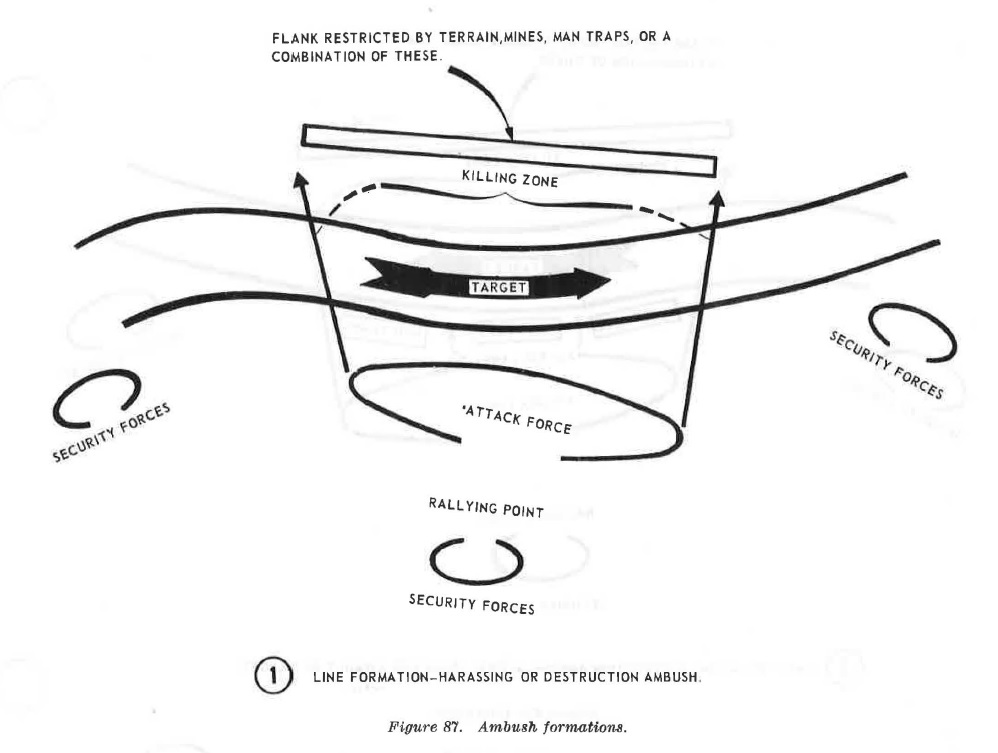
Figure 87. Ambush formations.
b. The L.
The L-shaped formation is a variation of the line formation. The long side of the attack force is parallel to the killing zone and delivers flanking fire. The short side of the attack force is at the end of, and at right angles to, the killing zone and delivers enfilading fire which interlocks with fire from the other leg.
This formation is very flexible. It can be established on a straight stretch of a trail or stream (3, fig. 87), or at a sharp bend in a trail or stream (4, fig. 87). When appropriate, fire from the short leg can be shifted to parallel the long leg if the target attempts to assault or escape in the opposite direction. In addition, the short leg prevents escape in its direction and reinforcement from its direction ( 5, fig. 87).
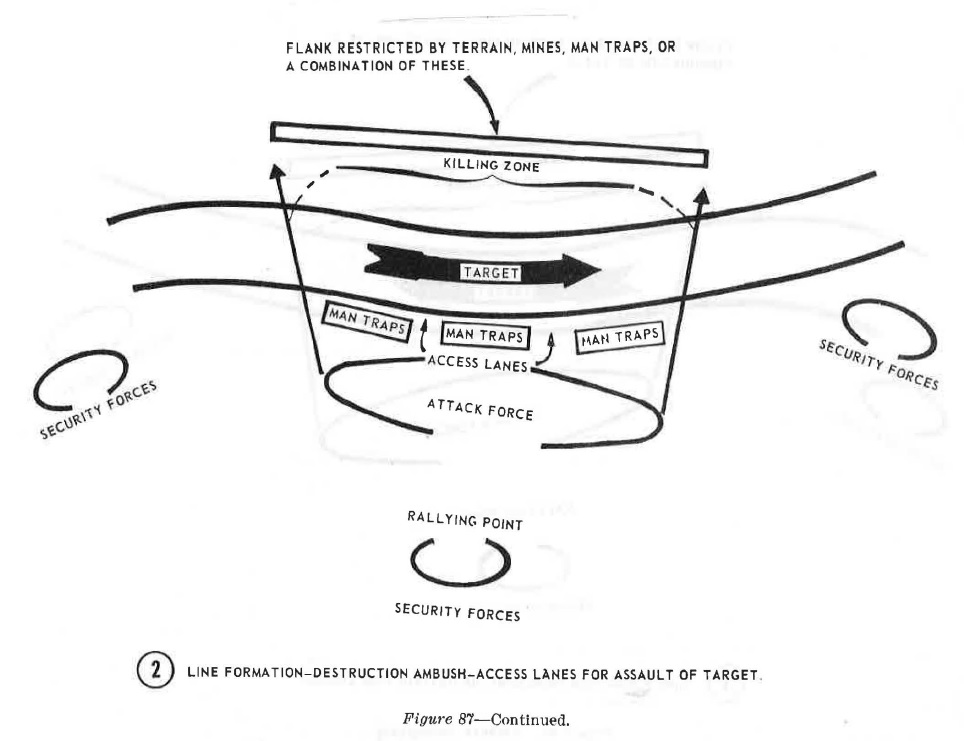
Figure 87. Continued.
c. The Z.
The Z-shaped formation is another variation of the line formation. The attack force is deployed as in the L formation, but with an additional side so that the formation resembles the letter Z. The additional side may serve any of the following purposes (6, fig. 87):
(1) To engage a force attempting to relieve or re-enforce the target.
(2) To seal the end of the killing zone.
(3) To restrict a flank.
(4) To prevent envelopment.
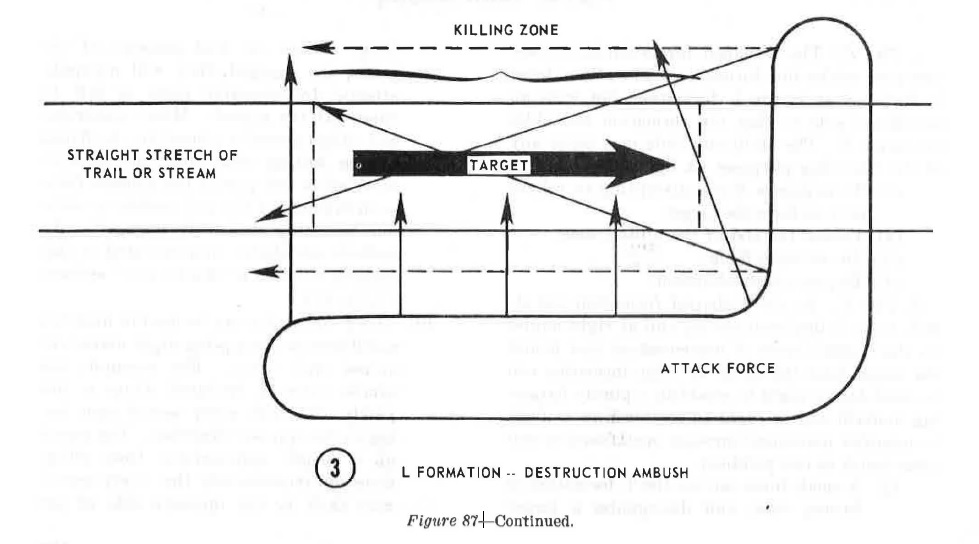
Figure 87. Continued.
d. The T.
In the T-shaped formation the attack force is deployed across, and at right angles to, the target's route of movement so that it and the target form the letter T. This formation can be used day or night to establish a purely harassing ambush and at night to establish an 1:1 ambush to interdict movement through open, hard to seal areas (such as rice paddies).
(1) A small force can use the T formation to harass, slow, and disorganize a larger force. When the lead elements of the target are engaged they will normally attempt to maneuver right or left to close with the ambush. Mines, mantraps, and other obstacles placed to the flanks of the killing zone slow the enemy's movements and permit the ambush force to deliver heavy fire and withdraw without becoming decisively engaged. An ambush established and executed in this manner is called a "bloody nose" ambush (7, fig. 87).
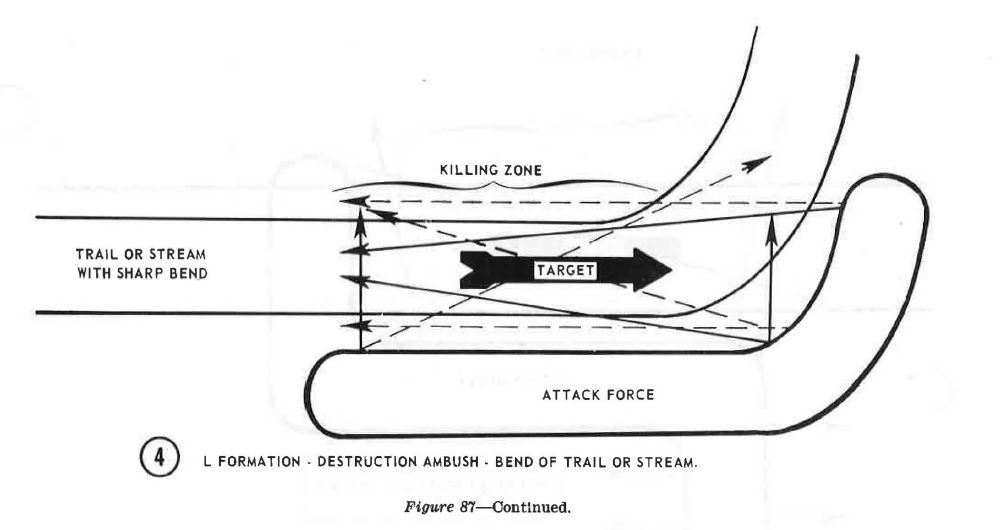
Figure 87. Continued.
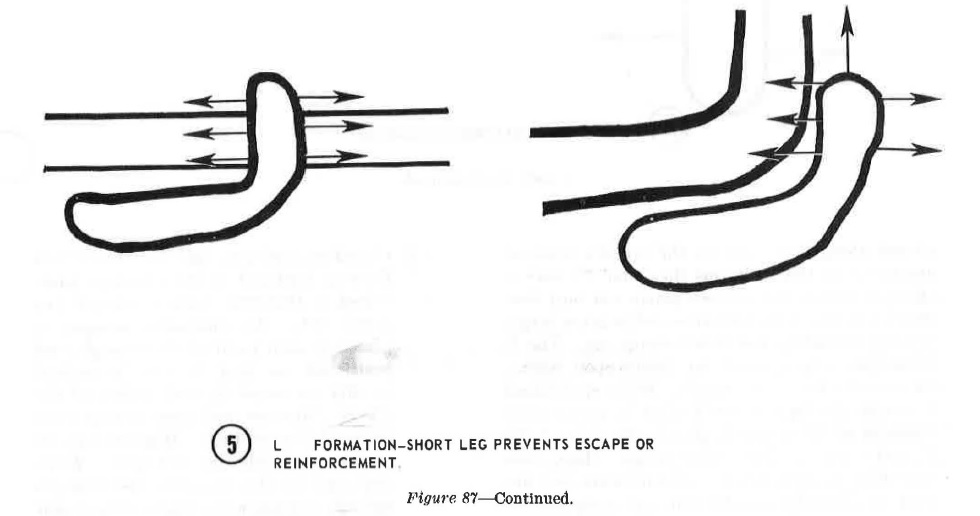
Figure 87. Continued.
(2) The T formation can be used to interdict small groups attempting night movement across open areas. For example, the attack force is deployed along a rice paddy dike with every second man facing in the opposite direction. The attack of a target approaching from either direction requires only that every second man shift to the opposite side of the dike. Each man fires only to his front and only when the target is at very close range. Attack is by fire only and each man keeps the target under fire as long as it remains on his front. If the target attempts to escape in either direction along the dike, each man takes it under fire as it comes to his vicinity. The T formation is very effective at halting infiltration. But it has one chief disadvantage there is a possibility that the ambush will engage a superior force at night while spread out. Use of this formation must, therefore, fit the local enemy situation (8, fig. 87).
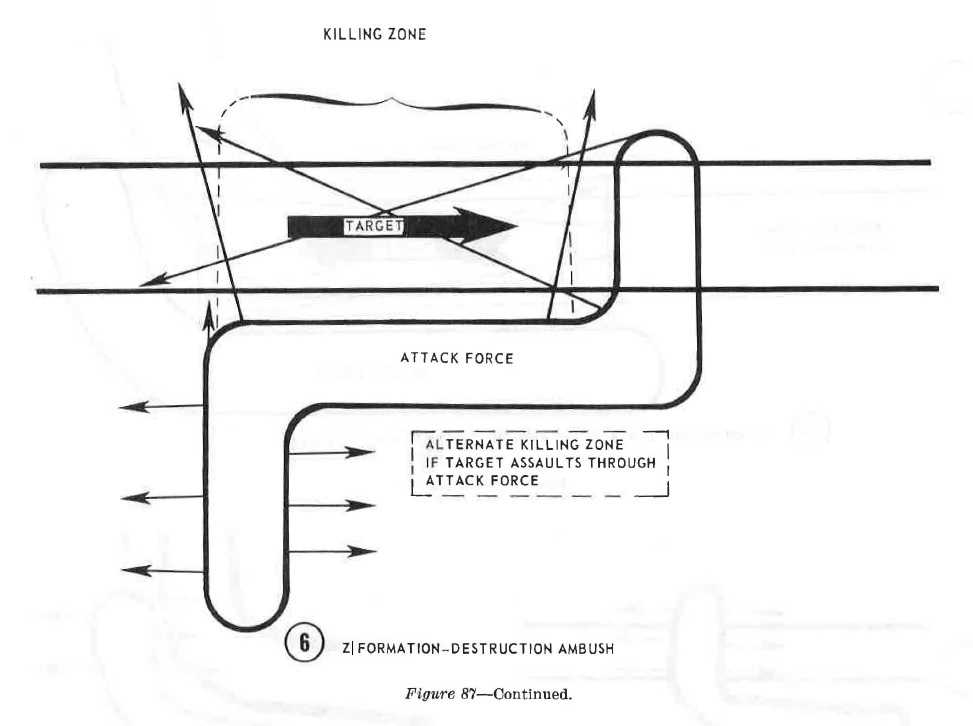
Figure 87. Continued.
e. The V.
The V-shaped attack force is deployed along both sides of the target's route of movement so that it forms the letter V; care is taken to insure that neither group (or leg) fires into the other. This formation subjects the target to both enfilading and interlocking fire. The V formation is best suited for fairly open terrain but can also be used in jungle.
When established in jungle, the legs of the V close in as the head elements of the target approach the apex of the V, and open fire from close range. Here, even more than in open terrain, all movement and fire must be carefully coordinated and controlled to insure that the fire of one V does not endanger the other. The wider separation of forces makes this formation difficult lo control and there are fewer sites that defend its use. Its main advantage is that it is difficult for the target to detect the ambush until well into the killing zone (9, 10, fig. 87).
f. Triangle. This is a variation of the V formation and can be varied in three ways.
(1) Closed triangle (11, fig. 87).
The attack force is deployed in three groups, positioned so that they form a triangle (or closed V). An automatic weapon is placed at each point of the triangle, and positioned so that it can be shifted quickly to interlock with either of the others. Men are positioned so that their fields of fire overlap. Mortars may be positioned inside the triangle. When deployed in this manner, the triangle ambush becomes a small unit strong point which is used to interdict night movement through rice paddies and other open areas, when target approach is likely to be from any direction. The formation provides all-round security and security forces are deployed only when they can be positioned so that, if detected by an approaching target, they will not compromise the ambush. Attack is by fire only and the target is allowed to approach within close range before fire is opened.
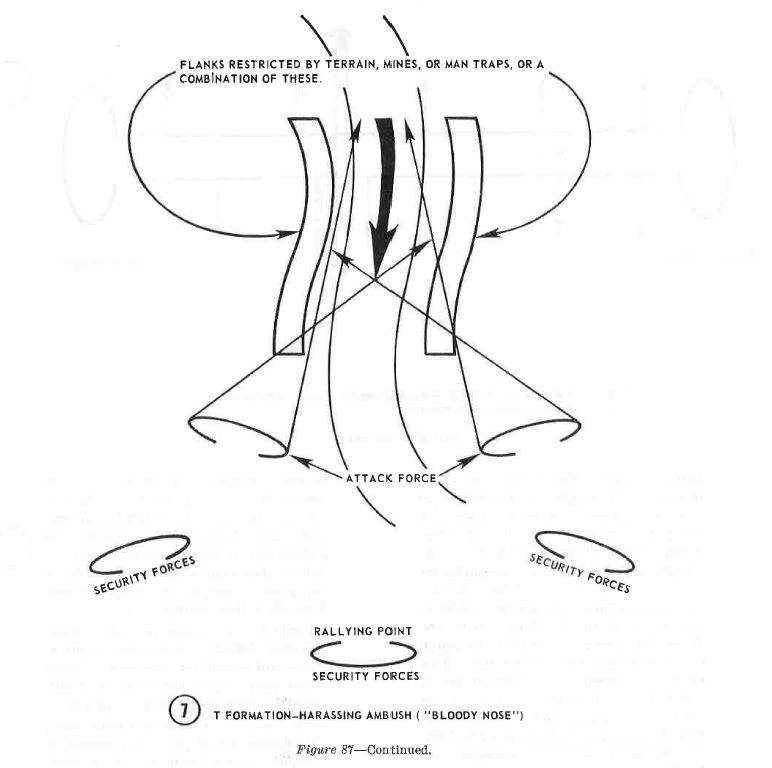
Figure 87. Continued.
(a) Advantages.
1. Ease of control.
2. All-round security.
3. A target, approaching from any direction, can be brought under fire of at least two automatic weapons.
(b) Disadvantages.
1. Requires an ambush force of platoon size or larger to reduce the danger of being overrun by an unexpectedly large target.
2. One or more legs of the triangle may come under enfilade fire
3. Lack of dispersion, particularly at the points, increases danger from enemy mortar fire.
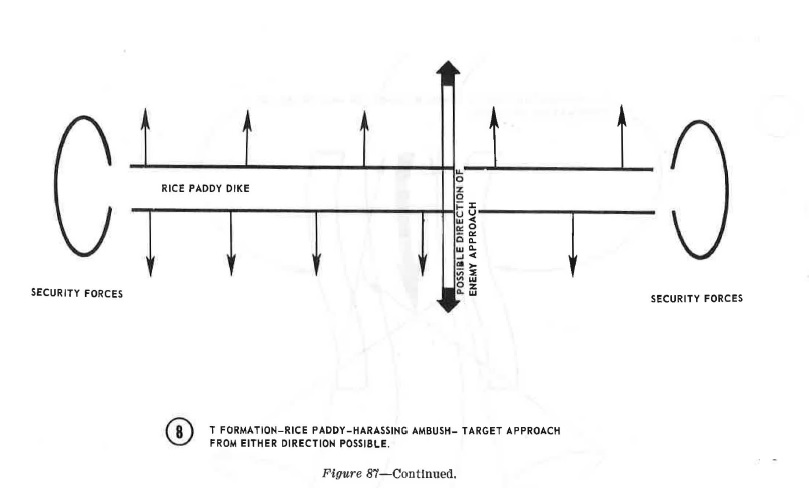
Figure 87. Continued.
(2) Open triangle (harassing ambush).
This variation of the triangle ambush is designed to enable a small force to harass, slow, and inflict heavy casualties upon a larger force without itself being decisively engaged. The attack force is deployed in three groups, positioned so that each group becomes a corner of a triangle containing the killing zone. When the target enters the killing zone, the group to the target's front opens fire on the leading element. When the target counterattacks, the group withdraws and a group to the flank opens fire. When this group is attacked, the group to the opposite flank opens fire. This process is repeated until the target is pulled apart. Each group reoccupies its position, if possible, and continues to inflict the maximum damage possible without becoming decisively engaged (12, fig. 87).
(3) Open triangle (destruction ambush).
The attack force is again deployed in three groups, position d so that each group is a point of tJ1e triangle, 200-300 meters a part. The killing zone is the area within the triangle. The target is allowed to enter the killing zone; the nearest group attacks by fire. As the target attempts to maneuver or withdraw, the other groups open fire. One or more groups, as directed, assault or maneuver to envelop or destroy the target (13, fig. 87). As a destruction ambush, this formation is suitable for platoon size or larger ambush forces. A unit smaller than a platoon would be in too great a danger of being overrun. Two other disadvantages are:
(a) Control, in assaulting or maneuvering, is very difficult. Very close coordination and control are necessary to insure that assaulting or maneuvering groups are not fired on by another group.
(b) The ambush site must be a fairly level, open area which provides (around its border) concealment for the ambush force (unless it is a "rise from the ground" ambush).
g. Born. This formation is similar in purpose to the open triangle ambush. The attack force is deployed in four groups, positioned so that each group becomes a corner of a square or rectangle containing the killing zone. It can be used for harassing or destruction ambush in the same manner as the two variations of the open triangle ambush (14, 15, fig. 87).
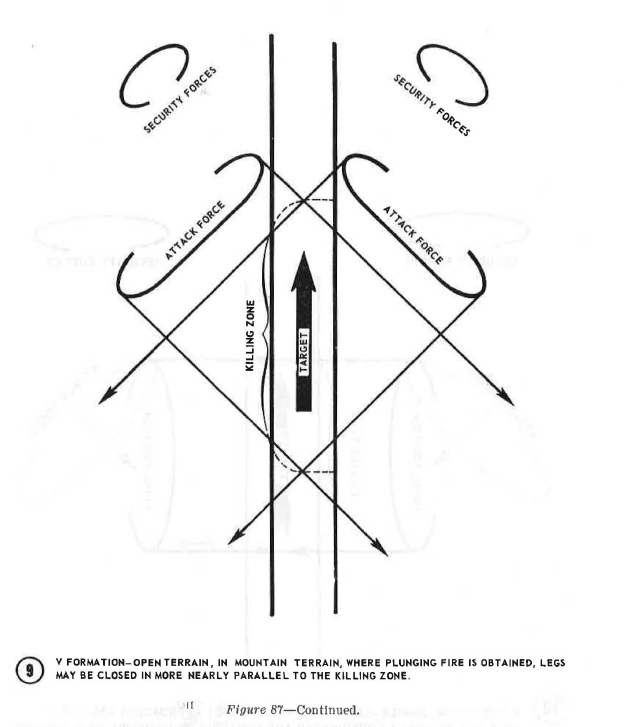
Figure 87. Continued.
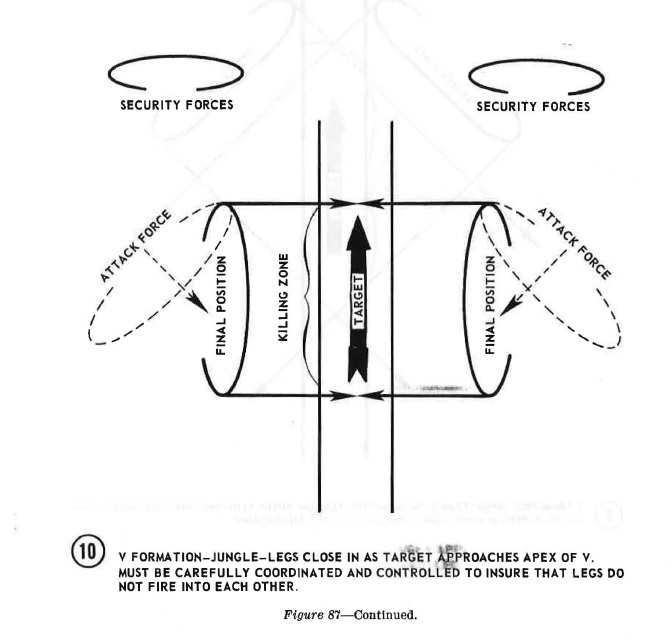
Figure 87. Continued.
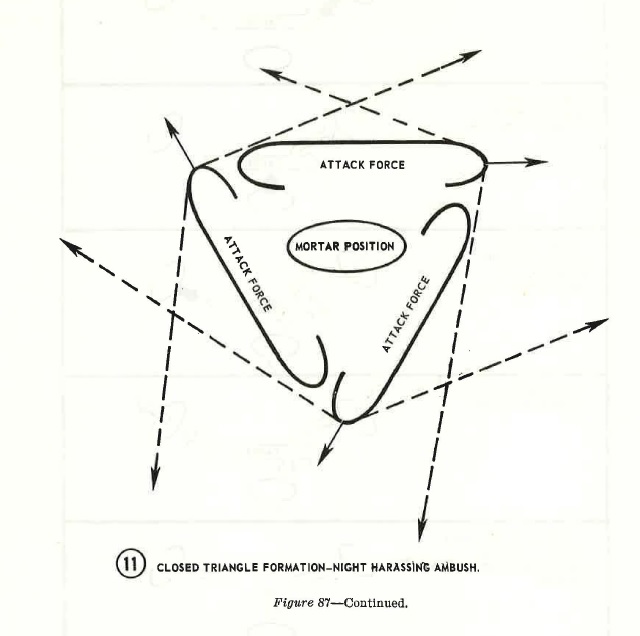
Figure 87. Continued.
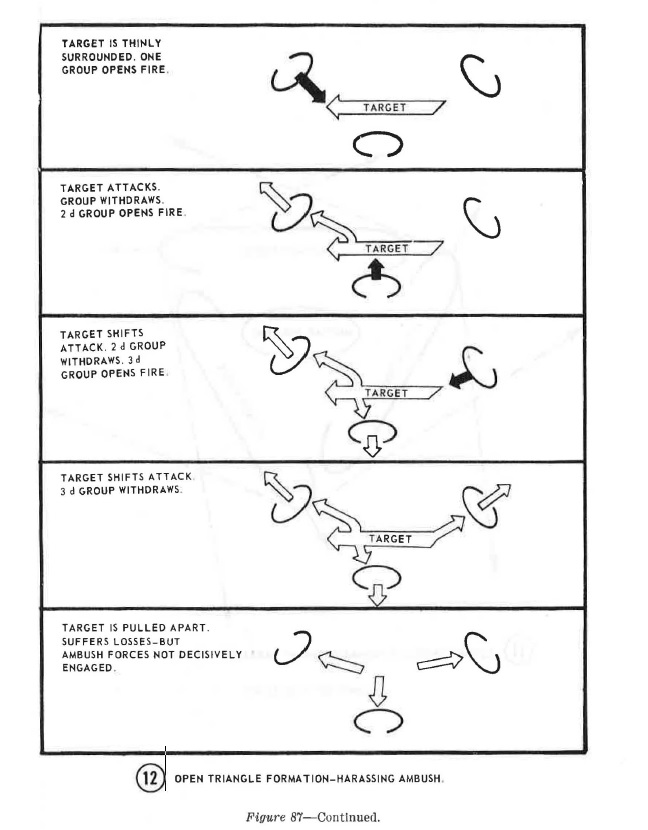
Figure 87. Continued.
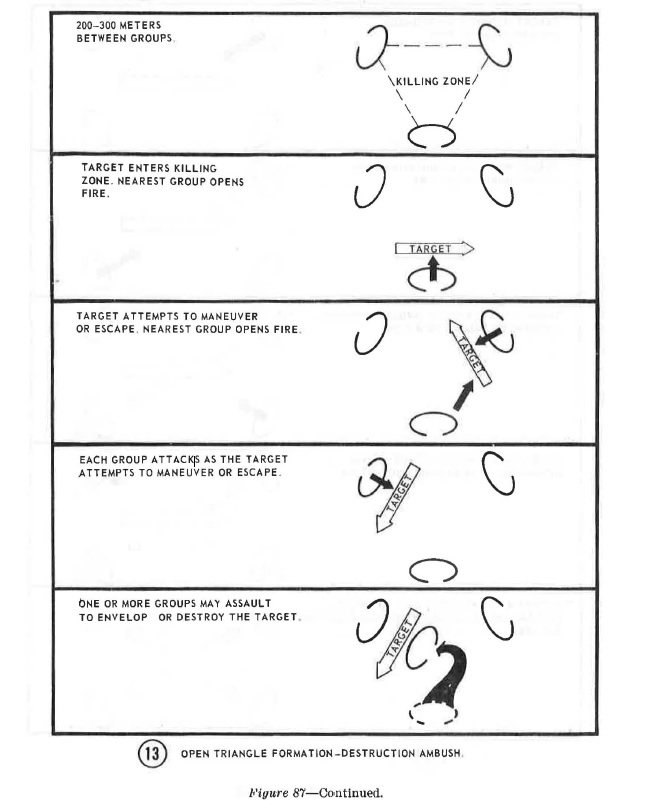
Figure 87. Continued.
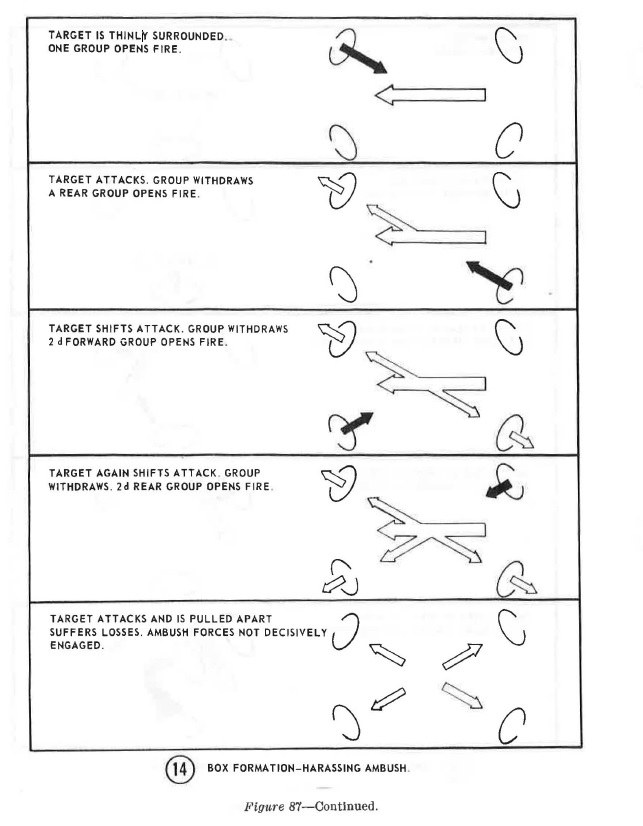
Figure 87. Continued.
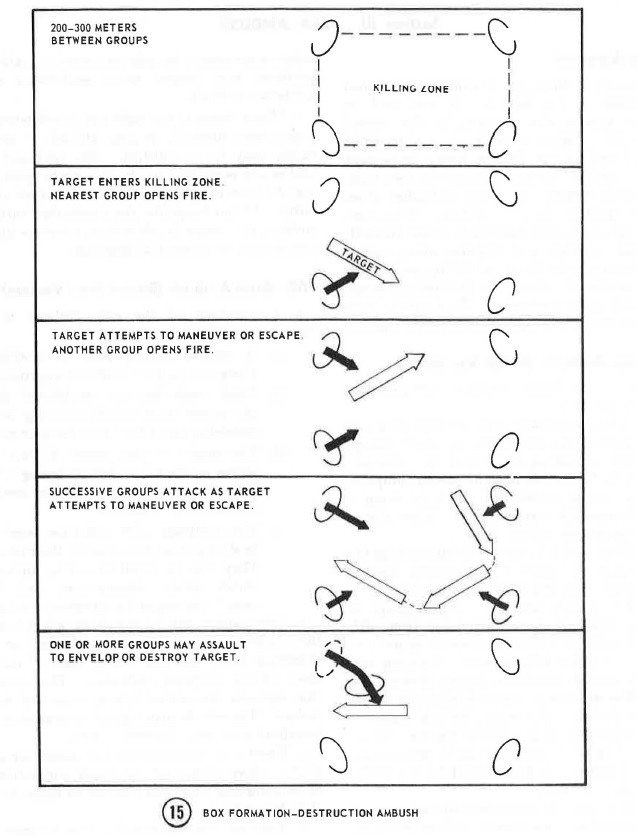
Figure 87. Continued.
SECTION III. AREA AMBUSH.
160. Background.
The origin of the type of ambush now called area ambush is not known. It was used by Hannibal against the Romans, in the second century B.C. More recently, it was modified and perfected by the British Army in Malaya and, with several variations, is used in Viet Nam. The British found that point ambushes often failed to produce heavy casualties. When ambushed, the communist guerrillas would immediately break contact and disperse along escape routes leading away from the killing zone. The British counteracted this tactic by blocking escape routes with point ambushes. They called these multiple related point ambushes the area ambush.
161. Area Ambush (British Version)
a. The British Army version of the area ambush is as follows:
(1) A point ambush is established at a site having several trails or other escape routes leading away from it. The site may be a water hole, an enemy campsite, a known rendezvous point, or along a frequently traveled trail. This site is the central killing zone.
(2) Point ambushes are established along the trails or other escape routes leading away from the central killing zone.
(3) The target, whether a single group or several groups approaching from different directions, is permitted to move to the central kill fog zone. Outlying ambushes do not attack (unless discovered).
(4) The ambush is initiated when the target moves into the central killing zone.
(5) When the target breaks contact and attempts to disperse, escaping portions are intercepted and destroyed by the outlying ambushes.
(6) The multiple contacts achieve increased casualties, harassment, and confusion (1, fig. 88).
b. This version of the area ambush is best suited to counter guerrilla operations in terrain where movement is largely restricted to trails. It produces best results when established as a deliberate ambush.
c. When there is not sufficient intelligence for a deliberate ambush, an area ambush of opportunity many be established. The outlying ambushes are permitted to attack targets approaching the central killing zone, if within their capability. If too large lor the particular outlying ambush, the target is allowed to continue and is attacked in the central killing zone.
162. Area Ambush (Baited Trap Version).
a. A variation of the area ambush is the "baited trap" version (2, fig. 88).
(1) A central killing zone is established along the target's route of approach.
(2) Point ambushes are established along the routes over which relieving or reinforcing units will have to approach.
(3) The target in the central killing zone serves as "bait" to lure relieving or reinforcing units into the killing zones of the outlying ambushes.
(4) The outlying point ambushes need not be strong enough to destroy their targets. They may be small harassing ambushes which delay, disorganize, and "eat away" the target by successive contacts.
o. This version con be varied by using a fixed installation as "bait" to lure relieving or reinforcing units into the killing zone of one or more of the outlying ambushes. The installation replaces the central killing zone and is attacked. The attack may intend to overcome the installation or may be only a ruse.
c. These two variations are best suited for situations where routes of approach for relieving or re-enforcing units are limited to those favorable for ambush.
d. They are also best suited for use by guerrilla forces, other than counter guerrilla forces. Both variations are extensively used by communist. guerrilla forces in Viet Nam.
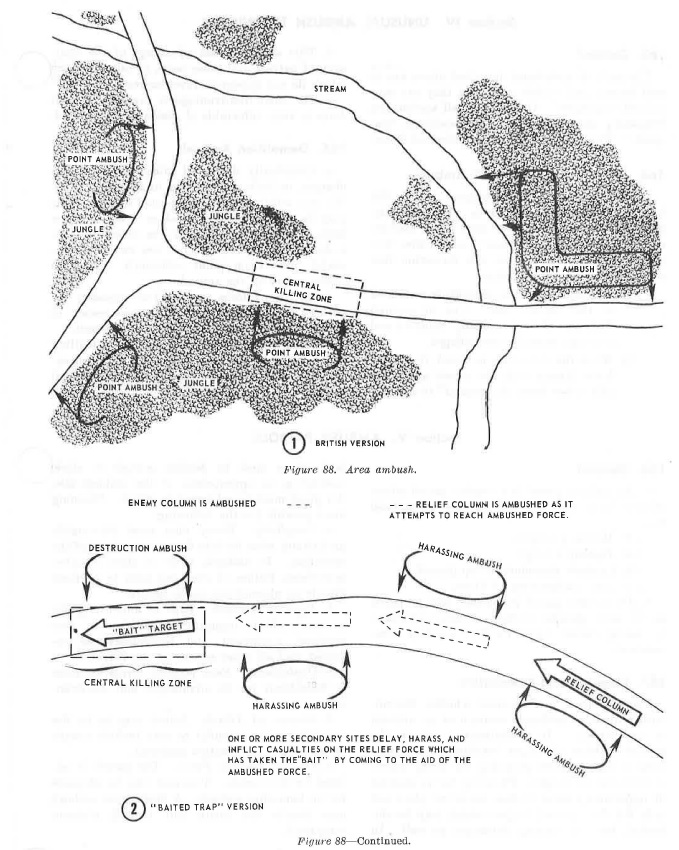
Figure 88. Area ambush.

Figure 88. Continued.
SECTION IV. UNUSUAL AMBUSH TECHNIQUES.
163. General
The ambush techniques described above are so well known and widely used that they are considered "standard." Other, less well known, less frequently used techniques are considered "unusual." Two such techniques are described below.
164. "Rise from the Ground" Ambush.
a. This point ambush is designed (1, fig. 89) to be established in open areas which lack the good cover and concealment and other features normally desirable in a "good" ambush site. The attack force is deployed in the formation best suited to the overall situation.
(1) The attack force is completely concealed in the "spider hole" type of covered foxhole. Soil is carefully removed and positions expertly camouflaged.
(2) When the ambush is initiated, the attack force throws back the covers and literally "rises from the ground" to attack.
b. This ambush takes advantage of the tendency of patrols, and other units, to relax in areas which do not appear to favor ambush.
c. The chief disadvantage is that the ambush force is very vulnerable if prematurely detected.
165. Demolition Ambush.
a. Electrically detonated mine3 or demolition charges, or both, are planted in an area (2, fig. 89) over which a target is expected to pass. This may be a portion of a road or trail, an open field, or any area which can be observed from a distance. Activating wires are run to a concealed observation point sufficiently distant to insure safety of the ambushers.
b. As large a force as desired or necessary can be used to mine the area. Two men remain to initiate the ambush; others return to the unit.
c. When a target enters the mined area (killing zone) the two men remaining detonate the explosives and withdraw immediately to avoid detection and pursuit.
SECTION V. AMBUSH PATROLS.
166. General.
a. An ambush patrol is a combat patrol whose mission is to establish and execute an ambush to:
(1) Harass a target.
(2) Destroy a target.
(3) Capture personnel or equipment.
(4) Any combination of these.
b. An ambush patrol is planned and prepared in the same general manner as other patrols by using Patrol Steps (Troop Leading Procedures).
167. Planning and Preparation.
Planning must first consider whether the ambush is to be a deliberate ambush or an ambush of opportunity. In a deliberate ambush the greater amount of target intelligence available permits and requires planning for every course of action at the target. Planning for an ambush of opportunity must include tentative plans not only for the types of targets which may be ambushed, but for varying situations as well. In both, plans must be flexible enough to allow modifying, as appropriate, at the ambush site. All plans must be rehearsed in detail. Planning must provide for the following:
a. Simplicity.
Every man must thoroughly understand what he is to do at every stage of the operation. In ambush, more so than in other operations, failure of even one man to perform exactly as planned can cause failure.
b. Type of Ambush.
Type of ambush (point or area) affects organization, number of men required, equipment and communications required, and all other aspects of the patrol.
c. Deployment.
Each possible formation must be considered for its advantages and disadvantages.
d. Manner of Attack.
Attack may be by fire only (harassing ambush) or may include assault of the target (destruction ambush).
e. Size of Ambush Force.
The patrol is tailored for its mission. Two men may be adequate for an harassing ambush. A destruction ambush may require the entire unit (squad, platoon, company).
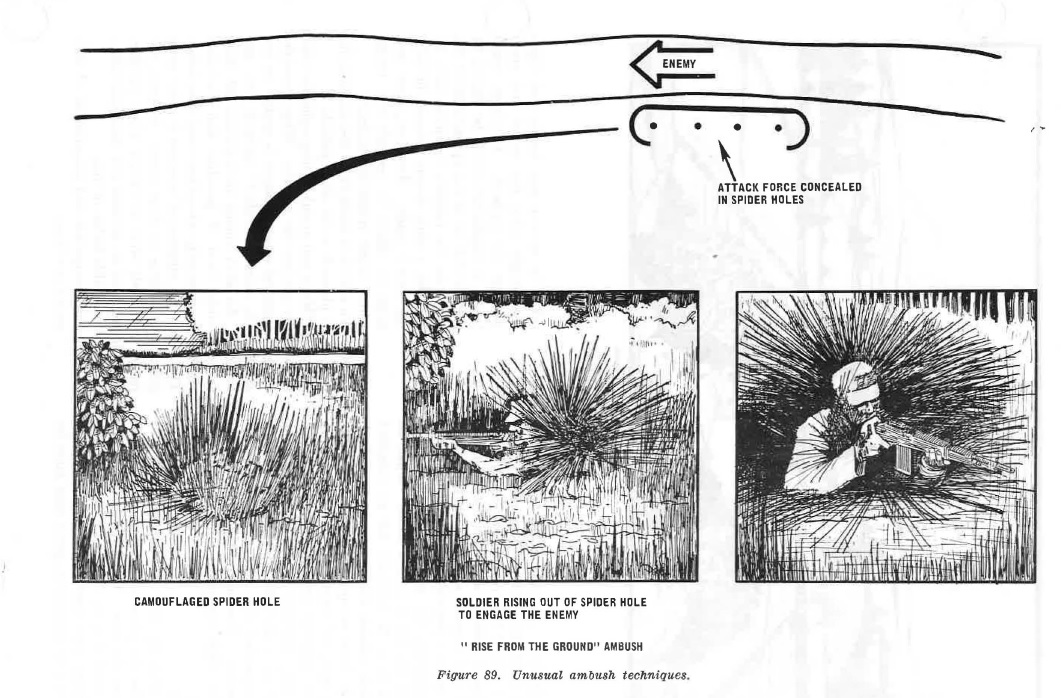
Figure 89. Unusual ambush techniques.
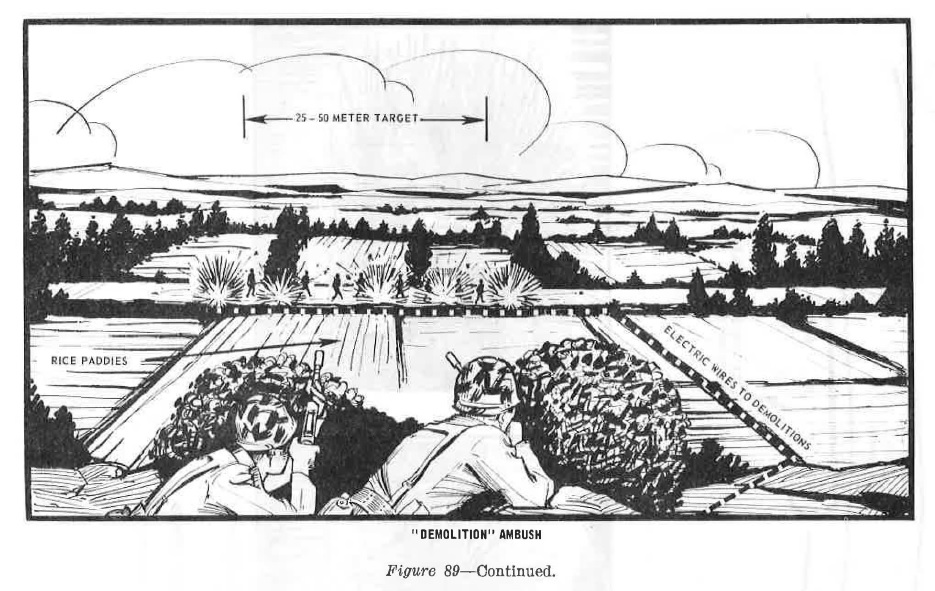
Figure 89. Continued.
f. Organization.
An ambush patrol is organized in the same manner as other combat patrols to include a patrol headquarters, an assault element, a support element, and a security element. The assault and support elements are the attack force; the security element is the security force. When appropriate, the attack force is further organized to provide a reserve force. When an ambush site is to be occupied for an extended period, double ambush forces may be organized. One ambush force occupies the site while the other rests, eats, and tends to personal needs at the objective rallying point or other concealed location. They alternate each 8 hours. If the waiting period is over 24 hours, three ambush forces are organized (fig. 90).
g. Equipment.
Remember the five general purposes for which equipment must be provided (para 122).
h. Routes.
(1) A primary route is planned which wil1 allow the patrol to enter the ambush site from the rear. The killing zone is not entered if entry can be avoided. If the killing zone must be entered to place mines or explosives, great care must be taken to remove any tracks and signs that might alert the target and compromise the ambush. If mines, mantraps, or explosives are to be placed on the far side, or if the appearance of the site from the target's viewpoint is to be checked, a wide detour around the killing zone is made. Here, too, great care must be taken to remove any traces which might reveal the ambush.
(2) An alternate route from the ambush site is planned, as in other patrols.
L Site.
Maps and aerial photographs are used to carefully analyze the terrain. When possible, an on-the-ground reconnaissance is made. As far as possible, so-called "ideal" ambush sites are avoided. An alert enemy is suspicious of these areas, avoids them if possible, and increases vigilance and security when they must be entered. The important element of surprise is even more difficult to achieve in these areas. Instead, apparently unlikely sites are chosen when possible. Considering this, an ambush site must provide:
(1) Favorable fields of fire.
(2) For occupation and preparation of concealed positions.
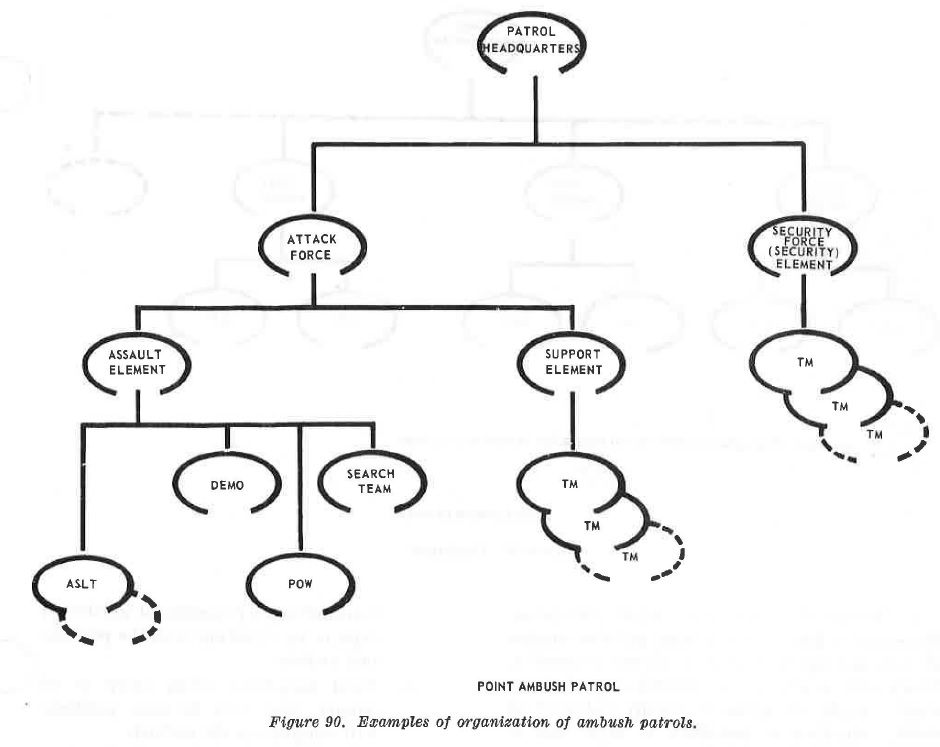
Figure 90. Example of organization of ambush patrol.
(3) ~analization of the target into the killing zone.
(4) Covered routes of withdrawal to enable the ambush force to break contact and avoid pursuit by effective fire.
j. Occupation of the Site.
As a general rule, the ambush force occupies the ambush site at the latest possible time permitted by the tactical situation and the amount of site preparation required. This not only reduces the risk of discovery but also reduces the time men must remain still and quiet in position.
k. Positions.
The patrol moves into the ambush site from the rear (h above). Security forces are positioned first to prevent surprise while the ambush is being established. Automatic weapons are then positioned so that each can fire along the entire killing zone. If this is not possible, they are given overlapping sectors of fire so that the entire killing zone is covered. The patrol leader then selects his position, located where he can tell when to initiate the ambush. Riflemen and grenadiers are then placed to cover any dead space left by the automatic weapons. All weapons are assigned sectors of fire to provide mutual support. The patrol leader sets a time by which positions are to be prepared. The degree of preparation depends on the time allowed. All men work at top speed during the allotted time.
l. Camouflage.
Camouflage is of utmost importance. Each man must be hidden from the target. During preparation for the patrol, each man camouflages himself and his equipment and secures his equipment to prevent noise. At the ambush site, positions are prepared with minimum change in the natural appearance of the site. All debris resulting from preparation of positions is concealed.
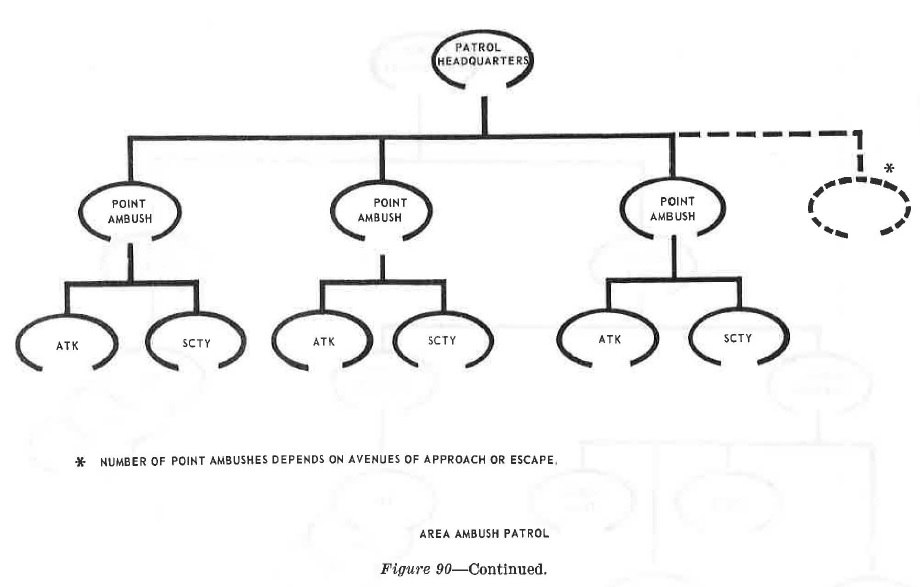
Figure 90. Continued.
m. Movement, Noise, and Light Discipline.
Movement is kept to a minimum and the number of men moving at a time is closely controlled. Every man is as quiet as possible, especially at night. Light discipline is rigidly enforced at night. Smoking is forbidden at night and is closely controlled in the day.
168. Execution
a. Signals.
Three signals, often four are needed to execute the ambush. Audible and visual signals, such as whistles and pyrotechnics, must be changed often to avoid establishing patterns. Too frequently use of the same signals may result in their becoming known to the enemy. A target might recognize a signal and be able to react in time to avoid the full effects of an ambush. For example: If a white star cluster is habitually used to signal withdrawal in a night ambush, an alert enemy might fire one and cause premature withdrawal.
(1) A signal by the security force to alert the patrol leader to the target's approach. This may be given by:
(a) Arm-and-hand signals.
(b) Radio, as a quiet voice message, by transmitting a prearranged number of taps, or by signaling with the push-to-talk switch.
(c) Field telephone, when there is no danger that wire between positions will compromise the ambush.
(2) A signal to initiate the ambush, given by the patrol leader or a designated individual. This may be a shot or the detonation of mines or explosives.
(3) A signal for lifting or shifting fires, if the target is to be assaulted. Voice commands, whistles, or pyrotechnics may be used. All fire must stop immediately so that the assault can be made before the target can react.
(4) A signal for withdrawal. This, too, can be voice commands, whistles, or pyrotechnics.
b. Fire Discipline.
This is a key part of the ambush. Fire must be withheld until the signal is given, then immediately delivered in the heaviest, most accurate volume possible. Properly timed and delivered fires contribute heavily to the achievement of surprise, as well as to destruction of the target. When the target is to be assaulted, the lifting or shifting of fires must be equally precise. Otherwise, the assault is delayed and the target has opportunity to recover and act.
c. Withdrawal to the Objective Rallying Point.
(1) The objective rallying point is located far enough from the ambush site that it will not be overrun if the target attacks the ambush. Routes of withdrawal to the objective rallying point are reconnoitered. Situation permitting, each man walks the route he is to use and picks out checkpoints. When the ambush is to be executed at night, each man must be able to follow his route in the dark.
(2) On signal, the patrol quickly but quietly withdraws to the objective rallying point, reorganizes, and begins its return march.
(3) If the ambush was not successful and the patrol is pursued, withdrawal may be by bounds. The last group may arm mines, previously placed along the withdrawal route, to further delay pursuit.